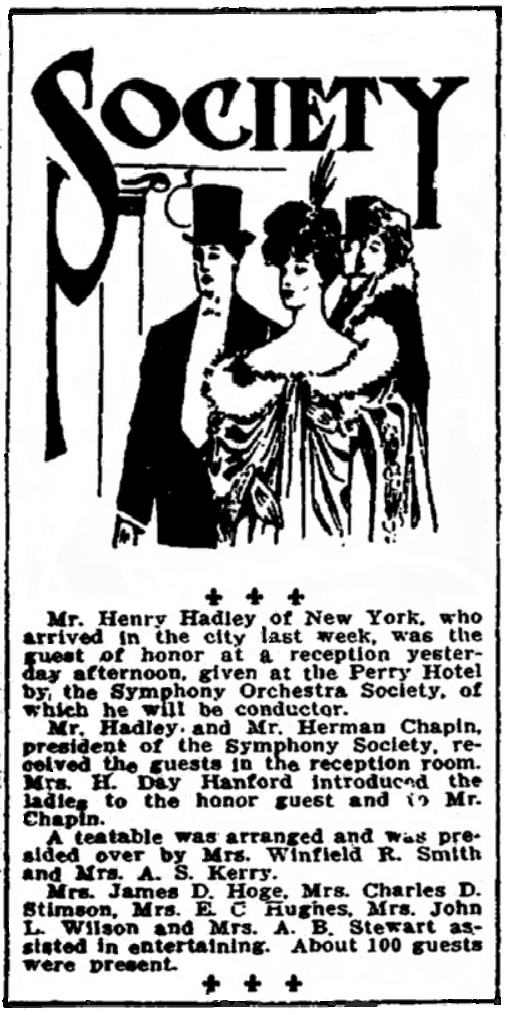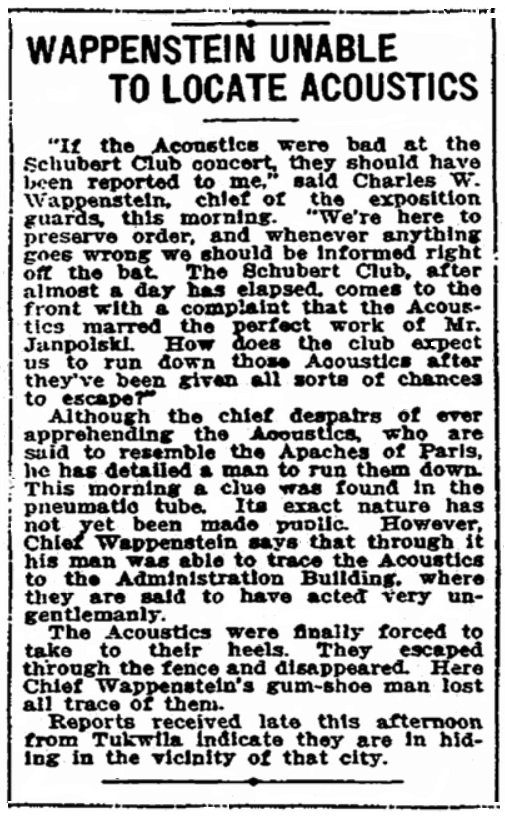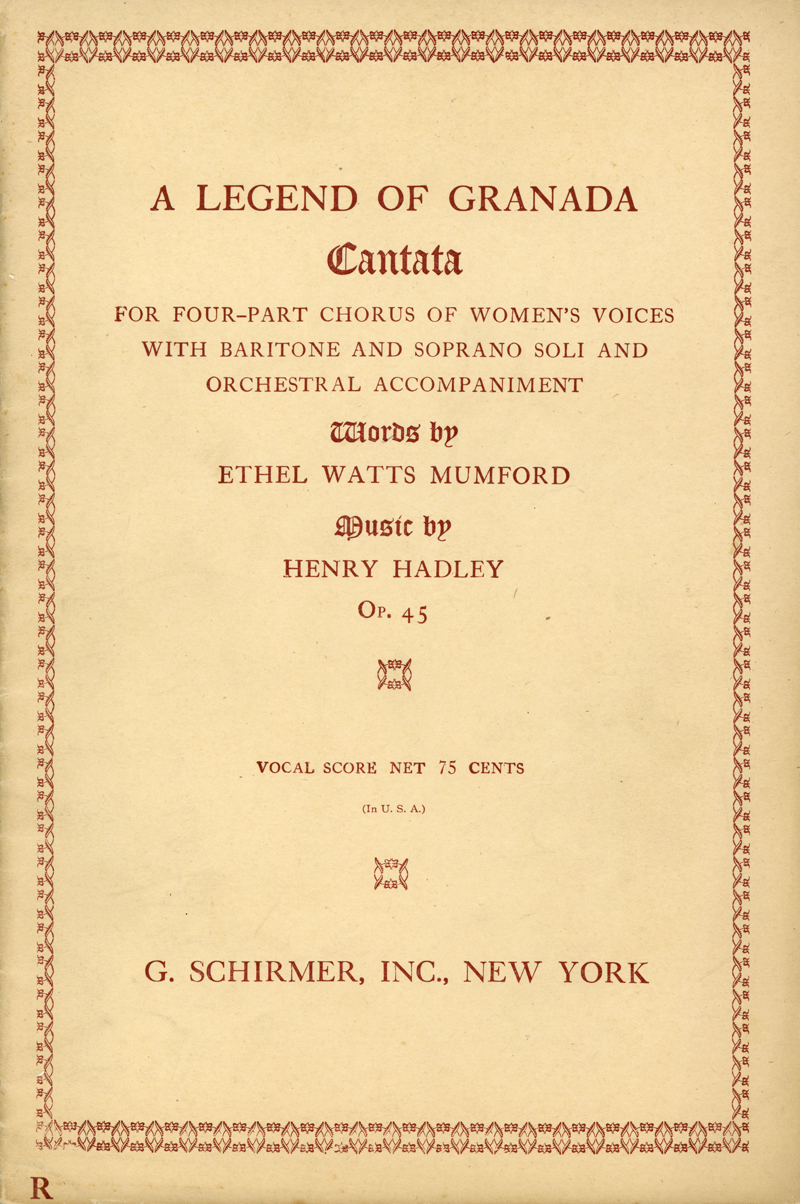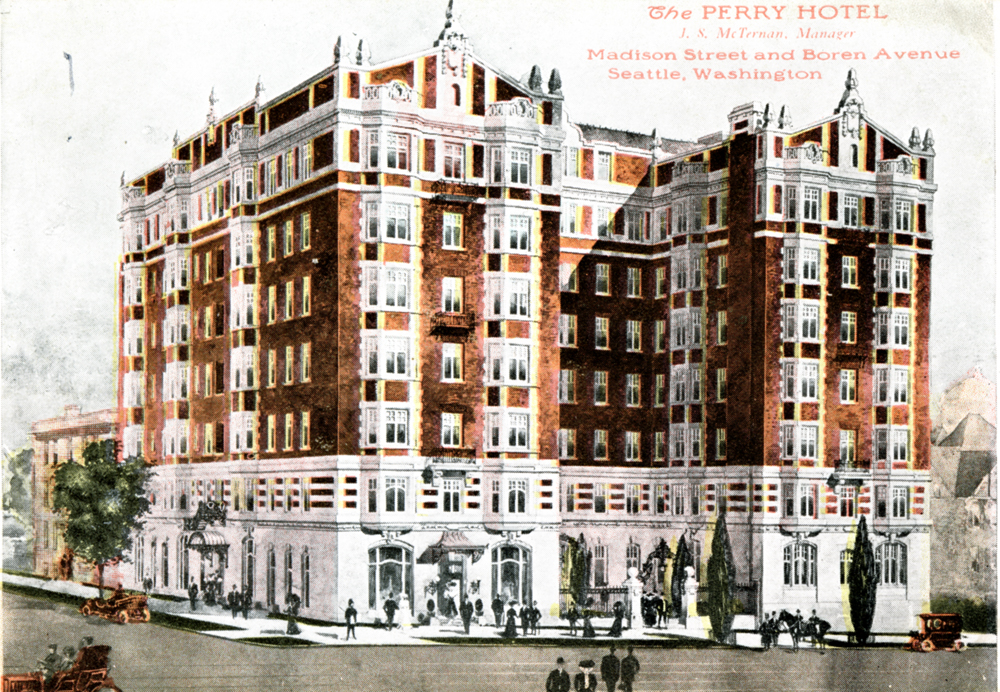Hadley in Seattle (under construction)
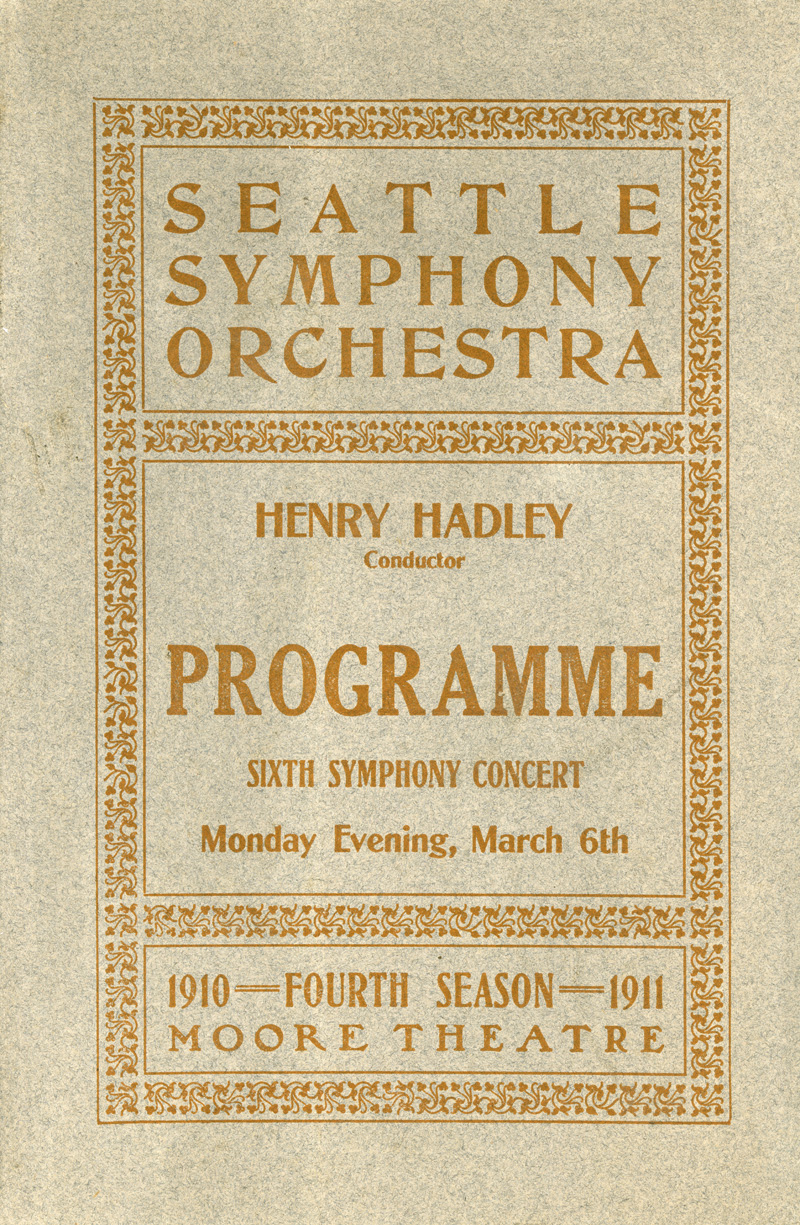
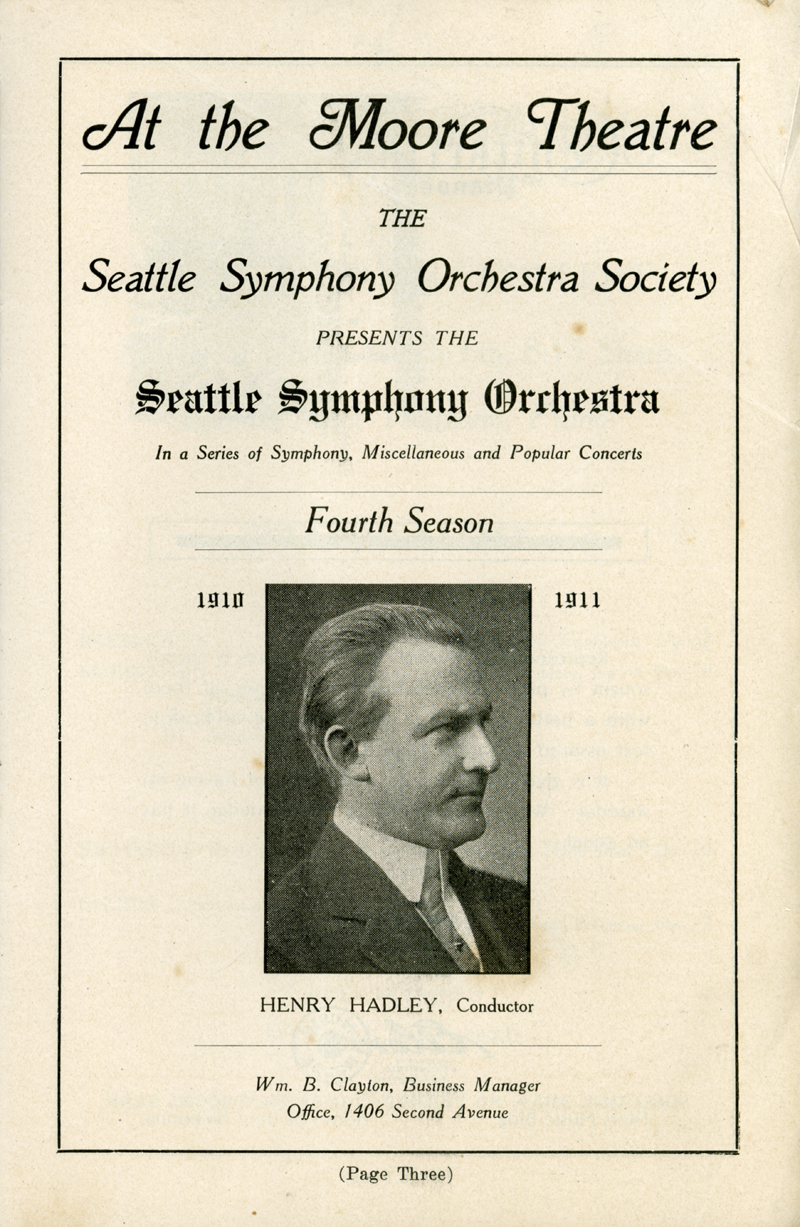
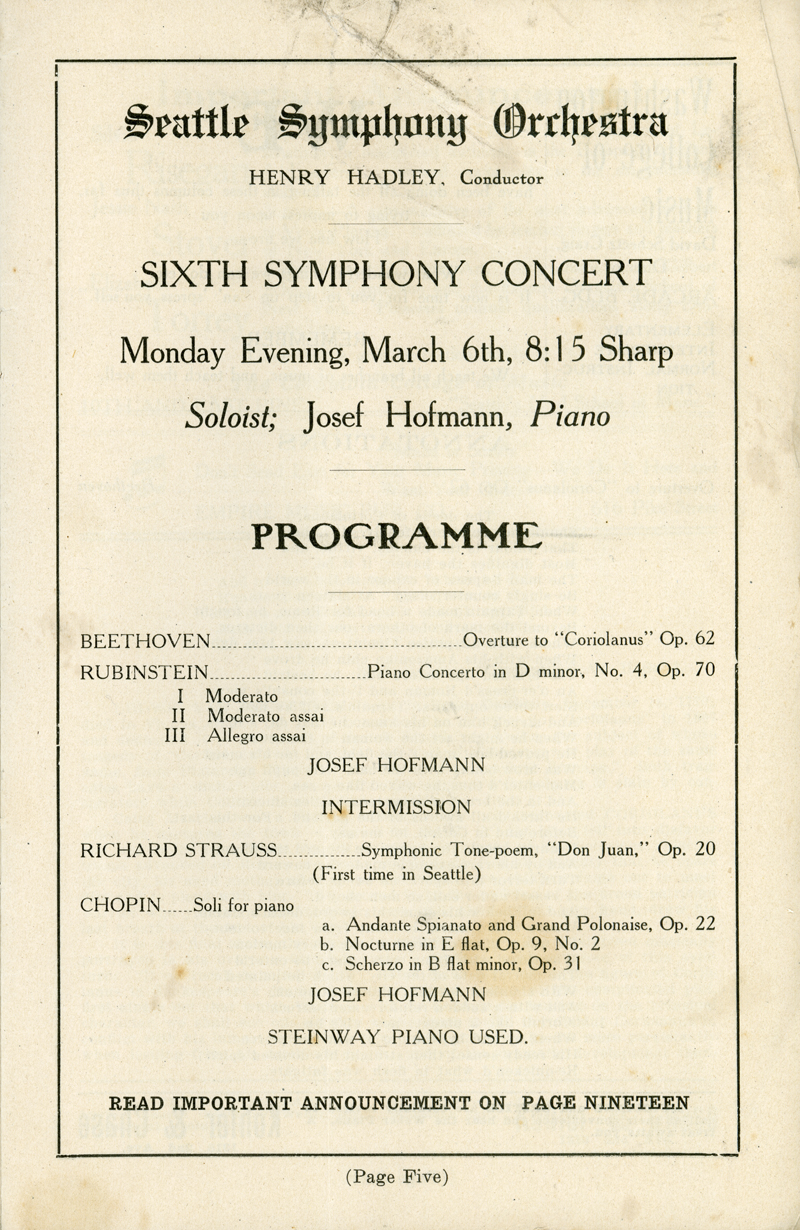
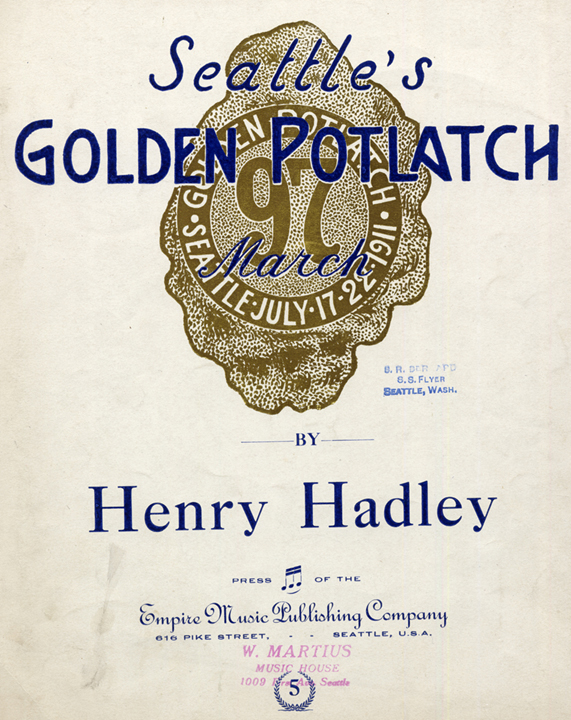
Seattle's Golden Potlatch March , composed in the spring of 1911. The Golden Potlatch was a grand, week long, Mardi Gras style festival that brought forth a high degree of artistic endeavor from several very noteworthy artists. Plans for the new fair evolved quickly and Hadley wrote his march in a very short time - as suited him well. He surprised the city with it - almost at least; words to the march were "leaked" to the press the day before, so that the audience might come prepared to sing along - at a regular concert of the Seattle Symphony, where it was encored. A fine march in the Sousa tradition, It is still heard on occasion in Seattle today. The Golden Potlatch festival - Potlatch is a Native American term for a great gift-giving celebration, Golden refers to the arrival of gold from Alaska that brought booming prosperity to the region - lives on today as Seattle's summer-long Seafair.
It was fitting that the final "pop" concert of the symphony orchestra should have been heard by the largest and most enthusiatic Sunday matinee audience ever gathered at a popular symphony event at The Moore. The house almost sizzled with joyful appreciation. Tremendous bursts of applause were showered repeatedly on Director Henry Hadley and Clarence Whitehill, the soloist...These "pop" audiences are a great study. They are quick to catch the significance of the novel and the unexpected as well as wide awake and discerning in their notice of the great.. when Director Hadley had finished his new march, dedicated to Seattle's Potlatch, the house rose in tribute and a loyal showing of enthusiastic approval. The balcony was crowded.. downstairs there were no vacant seats except for a few rows, while even the gallery was occupied. [a segregated upper balcony, accessible only by separate, outside stairs at the time, now fully integrated - ed.] A mighty wave of applause followed the conclusion of the new march, which Mr. Hadley repeated again, gaining a recall.
..
The Hadley march is certain to be a winner. Hadley shows all the spirit and dash of the redoubtable Sousa in the introduction. the melodic charm of the march will make it instantly popular, while the swinging chorus will make the "Potlatch" song the favorite tune of the populace all summer long. Seattle Times, April 17, 1911
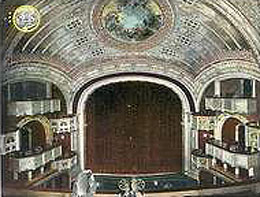
Seattle's ornate Moore Theatre, shortly after its opening in 1907. The theater is the oldest entertainment venue in the city that is still in use today, partly owing its longevity to its innovative freedom from view-blocking balcony supports that were standard at the time. Over the years many legendary performers of every stripe, hue, and style have graced its stage¹.
(improved scan of image to come)
Telegram from Henry Hadley to Harriet Overton Stimson, announcing his impending arrival in Seattle. Washington State Historical Society, Harriet Mary Overton Stimson papers MsSC 143. (please do not reproduce without obtaining permission).
Although he arrived on the slow, local train, Hadley was immediately embraced into the best of Seattle society. In his usual manner, he treated nabob and working musician alike with his customary graciousness, patience, and good will.
Hadley's opportunity to conduct an American orchestra, however young or small, came through unusual circumstances. The second conductor of the Seattle Symphony, Michael Kegrize, had battled the board through the 1908-09 season over music selection, particularly where audience-attracting soloists were injected into concerts without what he considered due appreciation of the overall program. In the summer of 1909, the Symphony had a contract to play each Sunday at the Alaska Yukon Pacific Exposition, a months-long World's Fair that attracted over four million persons. However, trouble ensued when the Fair's program director, Josiah Collins, tried to force inclusion of a singer into the regular programming. Displacement of the orchestra from the giant-timbered Forestry Building to an outdoor amphitheater was reportedly another issue. Details are sketchy, but the result was termination of the Symphony's contract, and the ending of Mr. Kegrize's Symphony directorship. Board President Mrs. C. D. (Harriet Overton) Stimson helped make arrangements to bring Hadley to Seattle. Hadley took up residence at the well-appointed Perry Hotel and immeditately began preparations for the fall seaon.
Seattle Times, Sept. 9 1909
September 24, 1909 was an American Composers' Day at the Alaska Yukon Pacific Exposition, and Hadley's song "Night Wind" was performed by a children's choir. But before July's hiatus ensued, Hadley's music had already been sung at the fair. The local Schubert Club performed Hadley's choral compositions A Hong Kong Romance and A Legend of Grenada on at least two occasions each, Grenada once in the Exposition Auditorium under less than ideal circumstances.
Charles "Wappy" Wappenstein, a longtime member and sometime chief of Seattle's police, was a colorful and endearing figure. He consistently outmaneuvered opponents, whether criminals or opposing politicians².
Despite having a new conductor - rehearals began in less than a month - the Symphony played no more concerts at the AYPE, depriving Hadley of an early chance to show his talents to an audience from around the world.
Seattle Times, June 8, 1909 p.7
Hadley continued the orchestra-building program begun by his predecessors, Harry West and Michael Kegrize. Hadley was also known, and revered, as a champion of American and other emerging composers, programming their little-known music to high degree. On his first concert as music director of a large sympony orchestra, he included the American premiere of Dutch pianist Dirk Schafer's Javanese Rhapsody, along with Tchaikovsky's Sixth Symphony, Weber's overture to Der Freischutz, and Wagner's overture to Die Meistersinger - an ambitious undertaking for his fledgling orchestra. (Seattle Times, October 25, 1909). During his two seasons in Seattle, the orchestra performed Hadley's In Bohemia and Herod, but Seattle audiences were denied a chance to hear his eagerly anticipated Fourth Symphony.
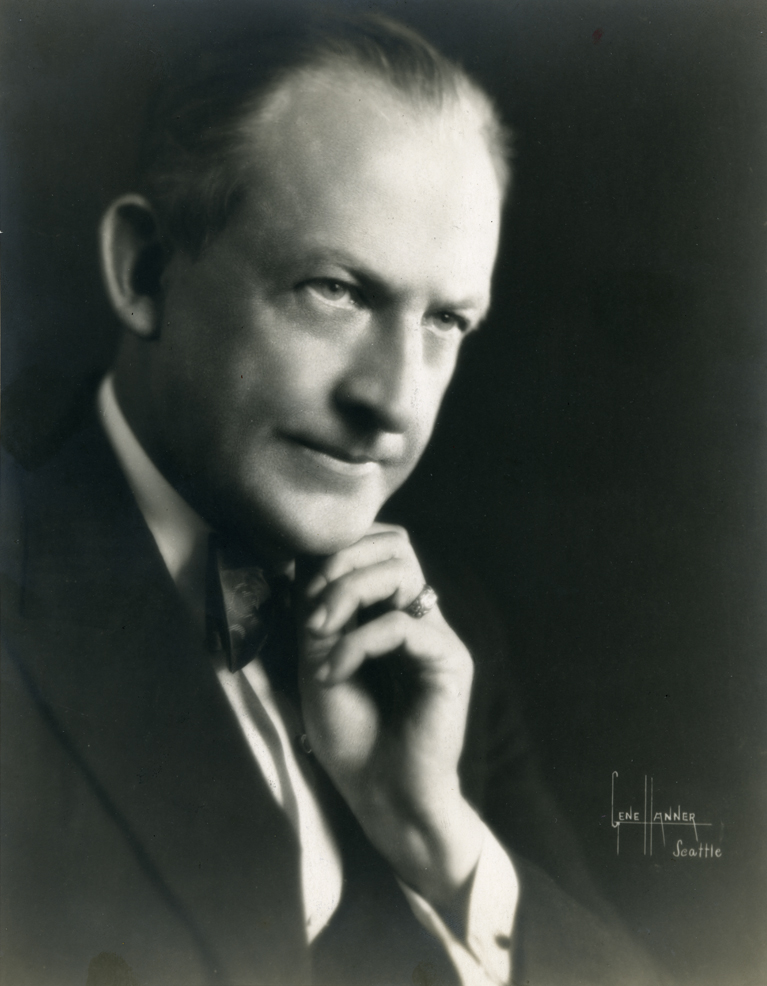
Hadley maintained ties with Seattle friends, and returned in 1921 conducting the New York Philharmonic, on tour. Portrait by Seattle celebrity photographer Gene (Genevive) Hanner, date unknown but possibly ca. Aug. 4 - 11, 1929 when he was scheduled to conduct a an assembled orchestra in special concerts at the University of Washington (Seattle Times, 6/5/1929 p. 13).
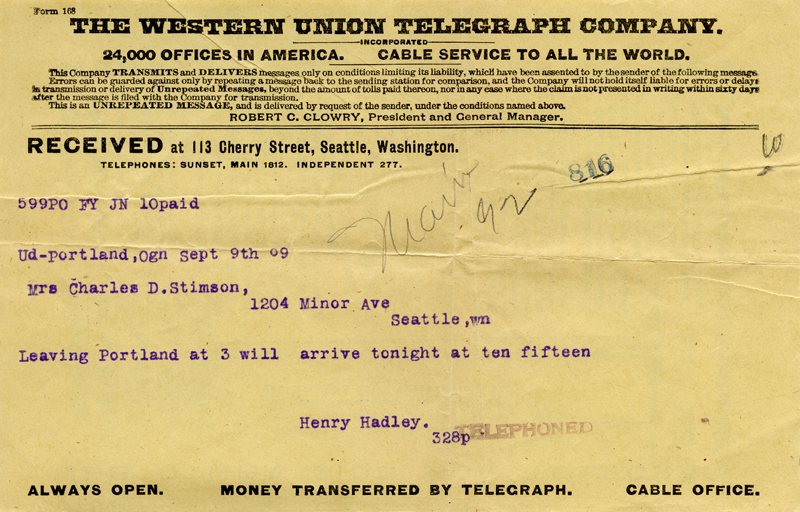
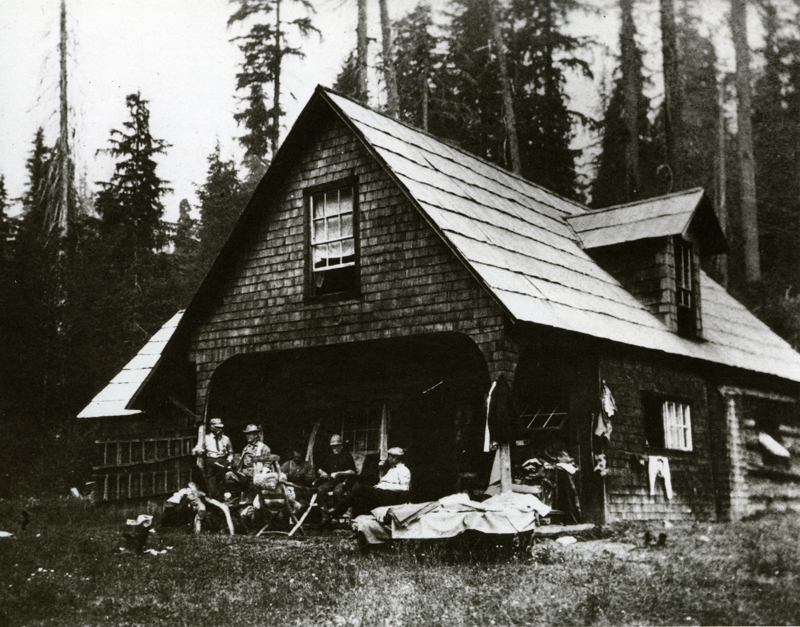
"The Willows", rustic hunting cabin of Charles D. and Harriet Overton Stimson, as located in today's Redmond, Wa., ca. 1905. Photographer unknown. Special thanks to Lawrence Kreisman for help in locating this image³.
Hadley completed his fourth symphony, North, South, East, West in the Stimson's cabin during the summer of 1910, as related in the Seattle Times:
.. a part of the new symphony was written last summer by Mr. Hadley while spending his vacation in a most beautiful retreat.. owned by C. D. Stimson. Here, amid ideal surroundings, Hadley worked from early morning till midnight for several weeks last summer. A grand piano at one side, his writing desk at the other, Hadley transformed the big living room of the Stimson cottage into a workshop, and worked as he never had before. (Seattle Times: Feb 12 1911, p. 24. the entire article will be provided soon).
The Willows farm/estate was located over the north half of today's Willows Golf Course, with an equal portion on the east side of the Sammamish River. It should not be confused with the Clise's WillowMoor estate to the south, now Marymoor Park, or Frederick Stimson's Hollywood Farm to the north, now the St. Michelle Winery.
North, South, East, West can be heard in a modern recording on the Naxos label, conducted by John McGlaughlin Williams.
Other important works were written during Hadley's time in Seattle, including the opera Azora and the Bohemian Grove musical play The Atonement of Pan. Pan became an important work with a life beyond its single Grove performance. Hadley composed a suite that was performed by the San Francisco Symphony, and several momements became well known to the public through recordings, piano rolls, sheet music sales, and as silent film cue sheet music. As noted by Hannah Lewis, in 1926-1927 the Finale of Pan was given new life as the title theme of Warner Brothers' groundbreaking, musical sound film, "When A Man Loves" (available on DVD, and please see further details in this website).
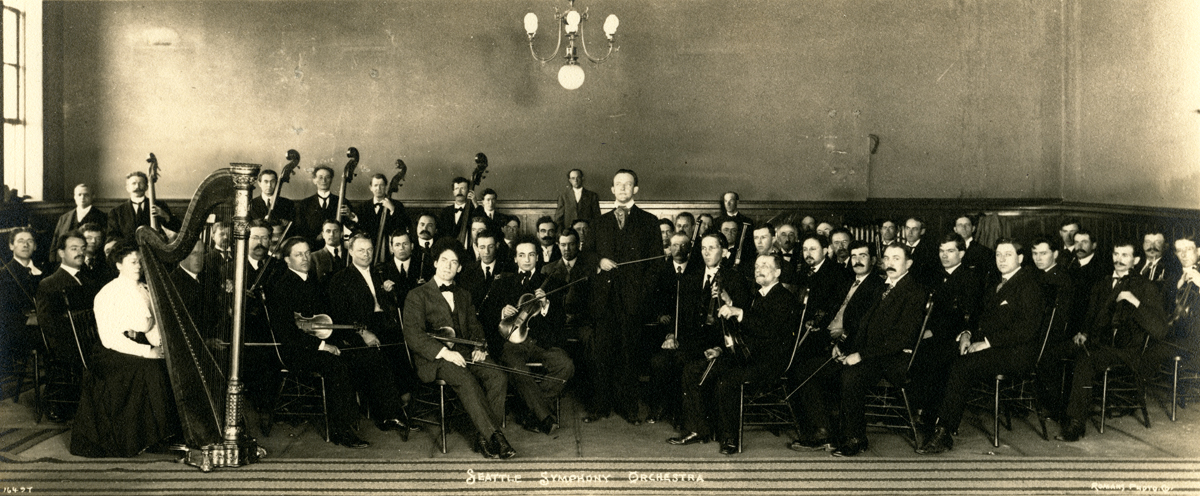
Hadley began rehearsing shortly after arriving in Seattle. Image by Asahel Curtis or William Romans, Romans Photographic Co. of Seattle, ca. September 1909. Location is in the Arcade Building on Second Avenue, directly across the street from the Symphony's present Benaroya Hall. The Arcade Building, now replaced by a newer structure, housed the Musician's Union offices and facilities at the time, but it was ninety years before the Symphony would perform regularly in this area of downtown. University of Washington Special Collections negative no. 36416 (Please do not reproduce without obtaining permission).
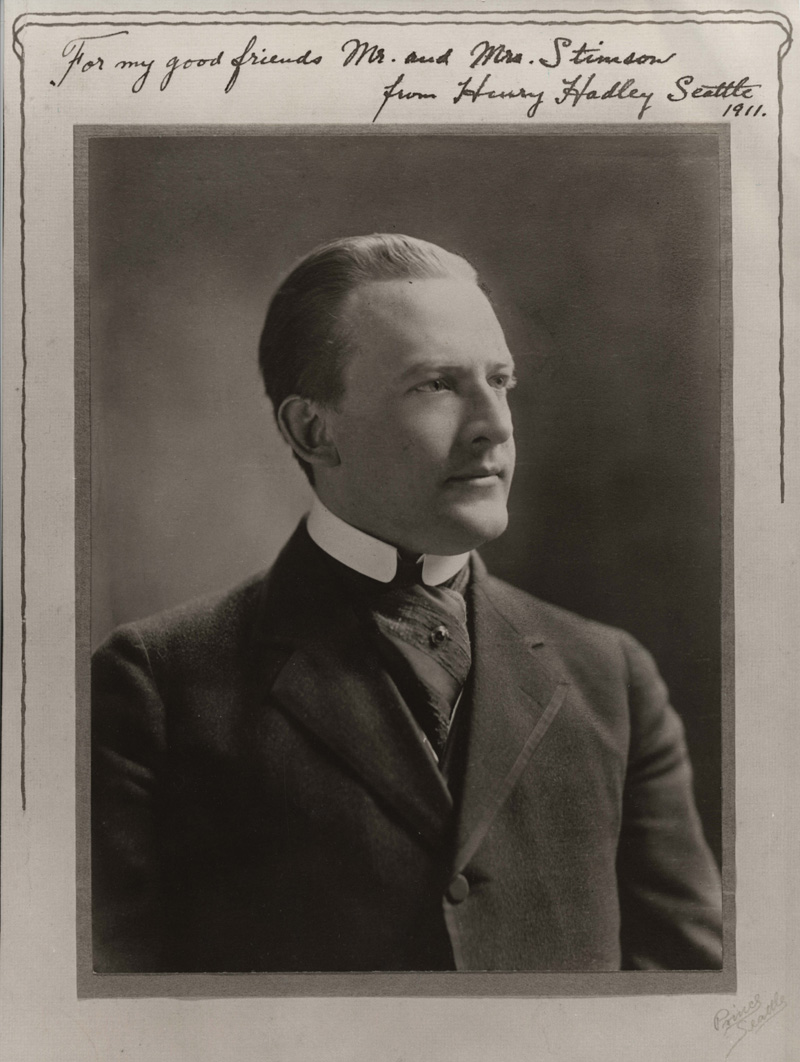
Hadley enjoyed an ongoing relationship with the C. D. Stimsons, who continued to support the Seattle Symphony after Harriet stepped down from the board presidency. The Stimson descendants, including Harriet's grandaughter, Harriet Stimson Bullitt, continue to sustain the arts and the environment in the area today. Portrait of Hadley by George Prince of Seattle, inscribed to C.D. and Harriet Overton Stimson, 1911. Museum of History and Industry, Seattle. (please do not reproduce without obtaining permission).
![]()
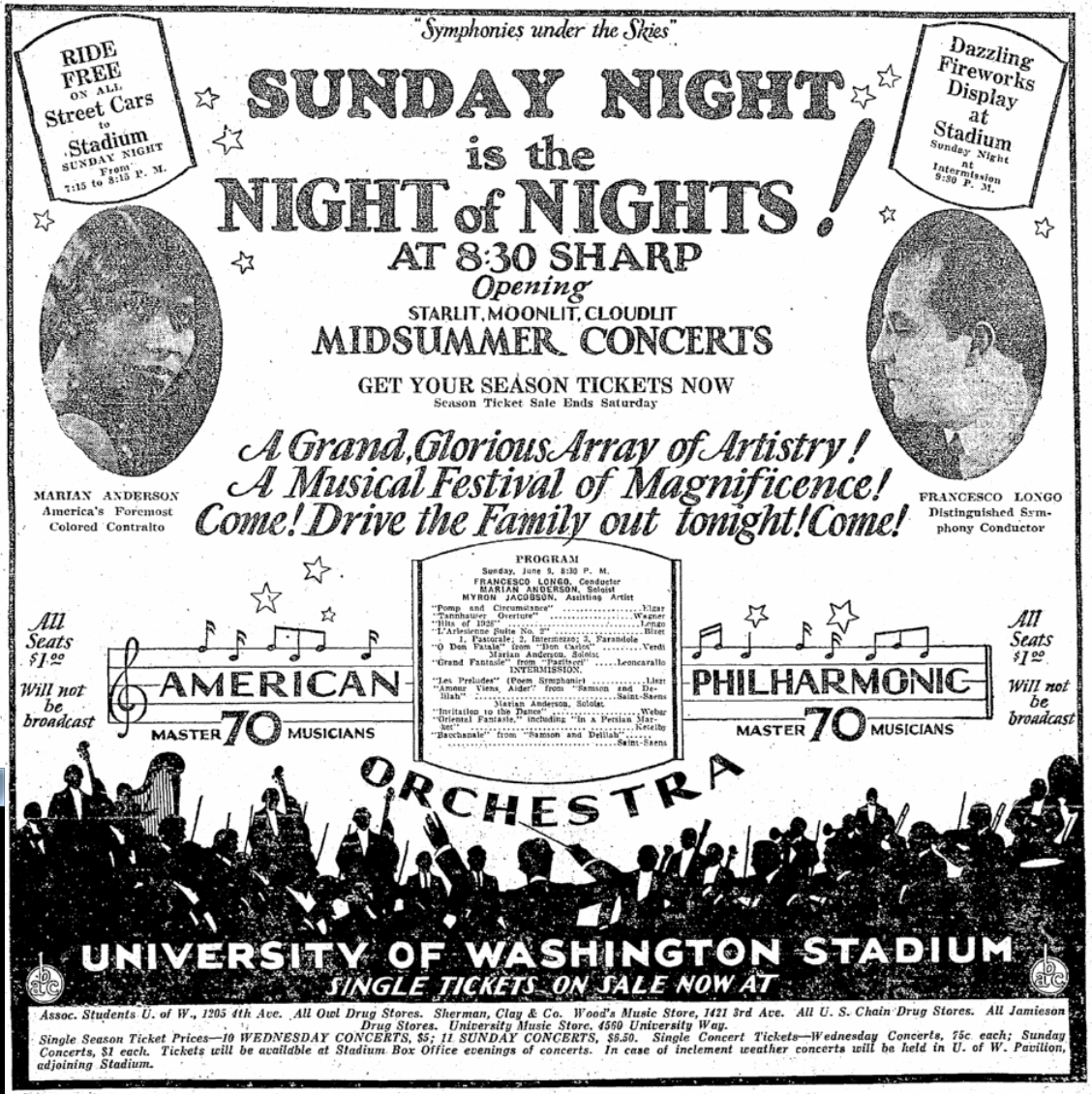
Hadley's name was regularly before Seattle residents during the late 1920s, as he was featured in many radio broadcasts as a conductor and composer ("American Broadcasting Company to offer another of Evenings with Famous Composers Series", Seattle Times June ,1928 p.24).
His tenure in Seattle was proudly recalled in a concert dedicated to his music, put on by the Seattle Oratorio Society in December of 1929 ("Hadley Concert will be Free to School Children", Seattle Times, May 5, 1929, p.21).
In the Summer of 1929, Hadley was one of several featured conductors and composers featured in a large musical festival held outdoors at the University of Washington stadium. Lucifer was among his compositions performed.
On September , 2003, the Seattle Symphony honored Henry Hadley in a special program to open its centennial season, performing his overture The Ocean. (Seattle Times, Sept. 15, 2003 p. E1 "Symphony in Top Form to open Centennial Season").
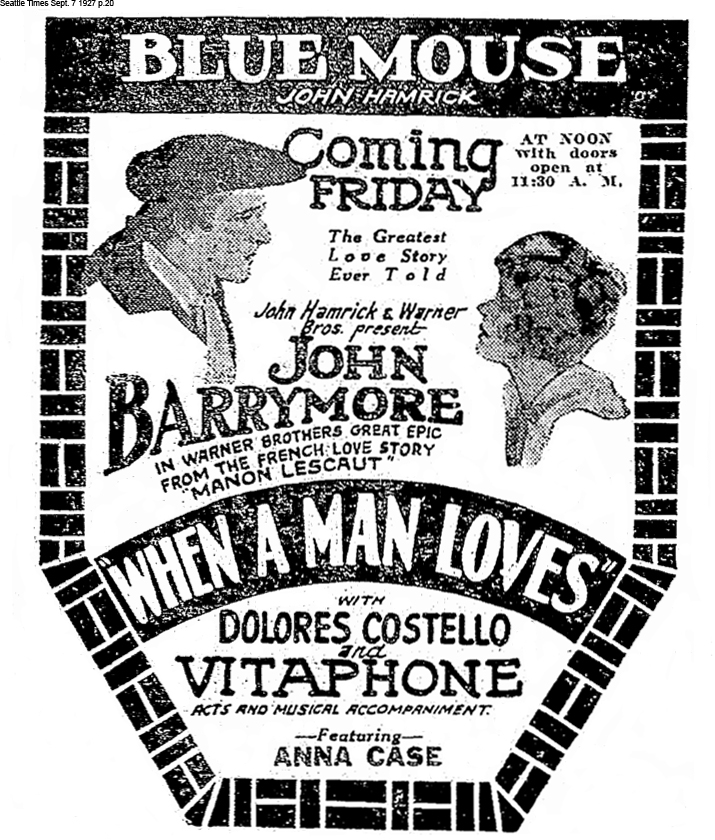

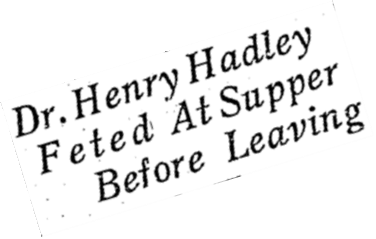
Seattle Times articles and headlines, summer 1929
Hadley's residence, the Perry Hotel (now the site of the Cabrini Tower medical center, Madison and Boren streets)
Summer festivals were a regular feature of Seattle's life during the 1920's often mingling U. S. Navy fleet visits, parades, and cultural extravaganzas. Hadley created music to accompany a great pageant, "The Wayfarer", set in a biblical context and produced around the country. It was produced several times in Seattle's University Stadium, including 1921 and 1925.






